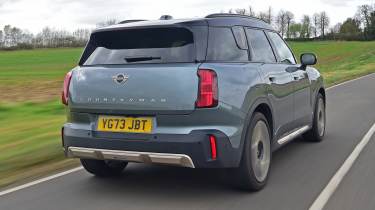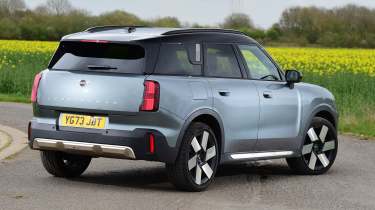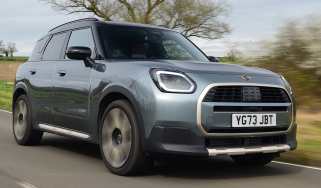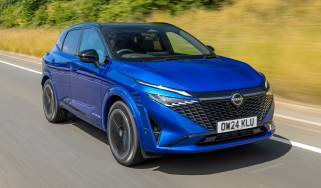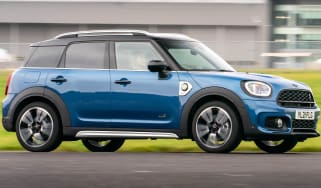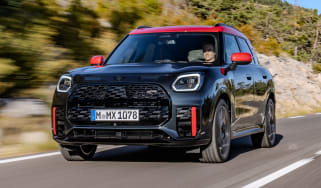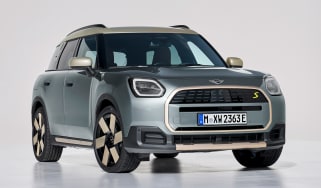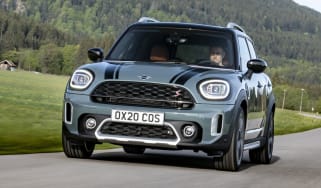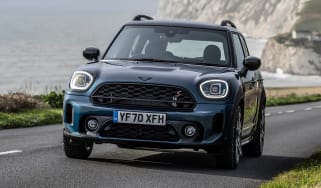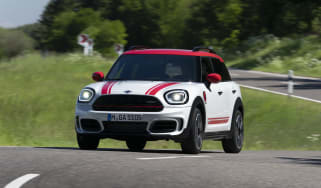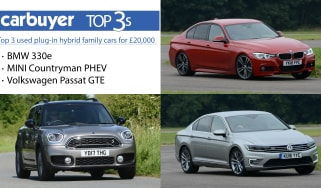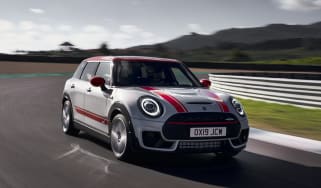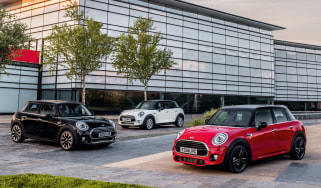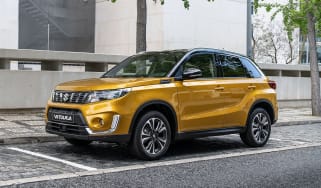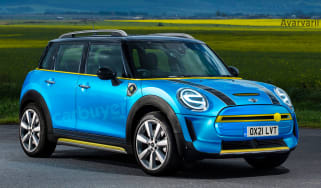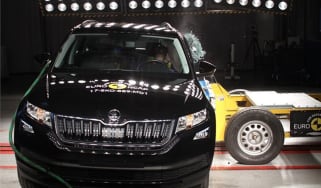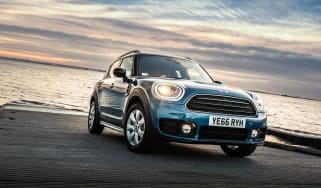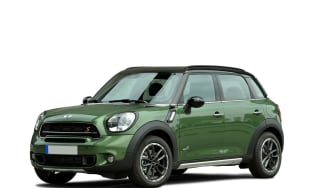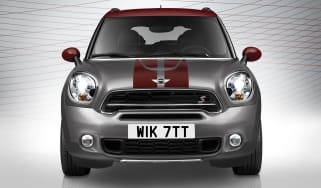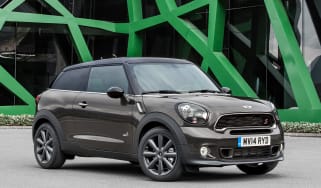MINI Countryman review – MINI charm in a practical package
The MINI Countryman has grown in size and become more practical, but brings that cheeky recipe the brand is known for
Pros
- More practical than before
- Good balance of comfort and driving dynamics
- Well-built interior
Cons
- Expensive
- JCW model not as fun as some rivals
- Notable wind noise at speed
Verdict – is the MINI Countryman a good car?
The latest MINI Countryman is larger and more practical than ever, making it one of the brand’s most compelling models yet. It’s expensive, especially in electric guise, but with great build quality and comfort, it will appeal to many buyers. While the Countryman certainly has a sense of fun, that has more to do with its cheeky nature and gimmicky Go Kart mode, and it’s less engaging than before in terms of the pure driving experience. We'd avoid the Countryman JCW, because it stretches the recipe somewhat too far.
MINI Countryman models, specs and alternatives
MINI’s largest car, the MINI Countryman SUV, is now in its third generation and offered not only as a petrol model, but as a fully-electric version, too. This generation of MINI Countryman isn’t just the largest car in the brand’s lineup, it’s the largest MINI ever – bigger even than rival mid-size SUVs such as the Nissan Qashqai, and both taller and longer than a Range Rover Evoque.
The latest MINI Countryman is based on the same underpinnings as the BMW X1 and X2 – two models which themselves are offered in petrol form or as pure-electric cars badged iX1 and iX2. The MINI Countryman takes that formula and injects the retro charm and style associated with the MINI brand, though this time around the Countryman’s design strays a little further away from the MINI Cooper hatchback, getting its own angular styling, most notably with those sharp, slanted headlights.
Petrol versions are badged Countryman C, Countryman S and the performance-focused John Cooper Works. Entry-level Countryman C gets 168bhp from a 1.5-litre mild-hybrid three-cylinder turbocharged engine, while the 2.0-litre mild-hybrid turbocharged four-cylinder engine in the Countryman S gives it a power figure of 215bhp. The performance-oriented John Cooper Works model uses the same 2.0-litre engine but is tuned to a higher output of 296bhp, which is actually down 5bhp on the equivalent outgoing Countryman JCW.
More reviews
There are two versions of the electric MINI Countryman, starting with the single-motor front-wheel drive Countryman E with 201bhp, and the dual-motor four-wheel drive Countryman SE ALL4 with a punchier 308bhp. The former gets the longest range, at up to 286 miles to a charge, while the higher-performance SE variant can travel up to 266 miles per charge, according to the official figures.
The MINI Countryman’s trim structure is a little more complicated than that of most cars, because following your choice between single or dual-motor configuration, you choose a ‘style’, the options for which comprise ‘Classic’, ’Exclusive’ or ‘Sport’. After that many of the Countryman’s options are incorporated into packs, designated ‘Level 1’, ‘Level 2’ and ‘Level 3’. Level 1 is standard on the mid-range Countryman S and SE models, as well as the JCW performance model, but costs £2,500 extra on Countryman C and E. Level 3 can only be optioned on ‘Exclusive’ style cars and above.
|
Trim levels |
Power options |
|
|
MINI Countryman alternatives
As a premium mid-size SUV, the electric MINI Countryman goes up against premium electric rivals such as the BMW iX1 with which it shares many underpinnings, or the Mercedes EQA. Both it and the petrol-powered Countryman have grown significantly since the last iteration, making this the largest MINI ever, comparable in size to mid-size family cars like the Nissan Qashqai and Range Rover Evoque.
Premium mid-size SUVs
Because the Countryman has grown in size, it could actually be considered alongside a fair few premium mid-size SUVs. The mid-range Countryman S is similar in price to premium rivals like the Volvo XC40, while the electric model’s higher price in comparison to the standard petrol’s also means you’re hitting territory with SUVs like the Audi Q3, which can be had in a higher specification for the price of a base electric MINI Countryman.
Premium electric SUVs
The electric MINI Countryman shares lots of its underpinnings with the BMW iX1, making the it a slightly cheaper alternative. There’s also the Mercedes EQA which can be had at just over the price of the top-spec Countryman SE model, and while the Skoda Enyaq is quite a bit larger – albeit a little less upmarket than the Countryman – its pricing puts it in similar territory in mid-range specification.
Should you buy a MINI Countryman?
The latest MINI Countryman is certainly a much-improved model compared to the outgoing car given it’s more practical and civilised than ever before. Admittedly its growth spurt will once again have purists debating whether it’s truly worthy of being called a ‘MINI’, but the Countryman delivers most of the charm, premium feel and fun the marque has come to be known for.
The electric MINI Countryman is undoubtedly expensive, especially in dual-motor SE trim, but it still delivers on that sense of charm and fun with all that added practicality, making it a compelling EV that could be one of the brand’s most convincing models yet.
While we’ve yet to test a standard petrol model, the John Cooper Works performance variant could be the version to avoid, because on British roads it felt overly hyperactive, bouncing from one bump to the next.
We were impressed with the electric Countryman SE, but its eye-wateringly steep £47,000+ price tag is hard to ignore. If your budget does stretch this far, you’ll be getting an undeniably fun and practical EV, but while we’ve yet to drive the front wheel-drive Countryman E, we suspect its more modest circa-£42,000 price will make it a more popular choice with buyers.
On the move, despite the electric model’s extra weight it strikes a fine balance between delivering a fun driving experience and composed, comfortable ride – better, in fact, than the setup used in the closely related BMW iX2.
The Countryman’s interior feels high quality, although it takes a more minimalist approach. Everything feels well put together, and we preferred the simpler, more tasteful teal-coloured interior of the Cooper SE we tested, rather than the slightly more garish black and red dash of the John Cooper Works. The circular OLED display in the centre of the dashboard was crisp and attractive, though some buyers might not like how busy it can get with all the information in one place.
Practicality is one obvious reason you’d buy a Countryman rather than the standard hatch, and the latest version makes improvements in this area. There’s plenty of space on the inside, with lots of headroom and legroom for rear passengers, and the boot is a good size. Admittedly there are more practical cars out there, but there’s now less of a trade-off in usability if you want that MINI charm.
What is the best MINI Countryman for low running costs?
The electric MINI Countryman E would be your best bet for low running costs. As it’s electric it should be cheaper to top up, but also boasts the longest range, at up to 288 miles compared with the SE’s 269-mile figure. VED road tax will be free until 2025, as will entry into the congestion-charge zone, and its zero-emissions status means it sits in the lowest BiK (Benefit-in-Kind) tax band for company-car buyers.
What is the best MINI Countryman for keen drivers?
The MINI Countryman John Cooper Works should be a slam dunk in this section, but when we drove it in the UK we found it too clumsy to recommend. If straight-line performance is important to you, it's certainly no slouch (using the same 296bhp engine as the sporty M35i versions of the BMW X1 and X2), but it's actually Countryman models lower in the range that we expect to feel more composed.
How we tested the MINI Countryman
We’ve driven the dual-motor electric MINI Countryman SE, as well as the petrol performance version, the Countryman John Cooper Works, on European roads.

